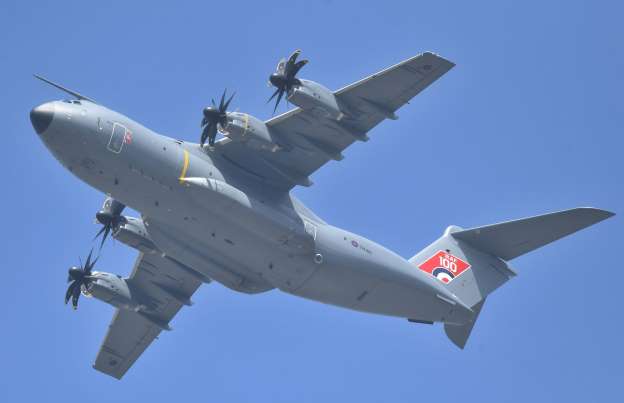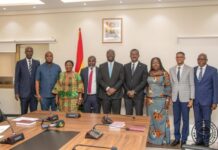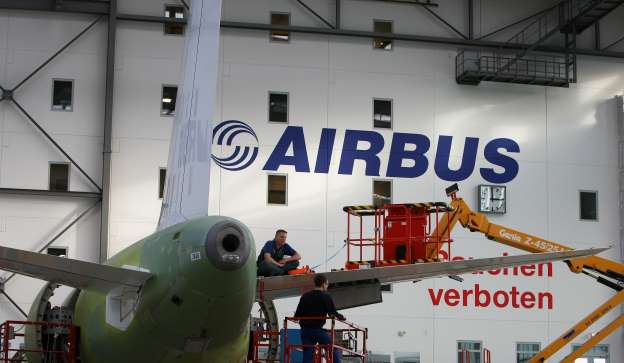
The giant propeller system on the wing of the A400M is known as El Toro to the Airbus workers who assemble the military transport aircraft outside Seville. At 683kg, not only does the propeller weigh roughly the same as a young prize bull, but up close its 5.3m span conveys the same impression of enormous power.
And like a bull, the A400M programme has been an unpredictable beast. The challenges of developing a multi-role heavy lift aircraft using new engine and composite technologies have torn up the planning of the seven nations who backed its development and the finances of the company that took on the contract.
Since its launch in 2003, it is estimated that Airbus has recorded provisions of some €8bn ($9.3bn) — the latest of €1.3bn in February — on a programme originally expected to cost €20bn. The first aircraft was delivered four years late — to France, which has since been forced to buy alternative lifters to cover the gap caused by delays.
Since that first delivery, the programme has been plagued by persistent capability shortfalls, new delays and technological problems, the gravest of which led to the deaths of four crew after an aircraft crashed in 2015.
Now Fernando Alonso, Airbus’s head of military aircraft, wants to reassure existing and potential customers that the programme’s troubled history is nearing its end.
The industrial problems that hampered the programme and led to management changes in 2015 have been resolved, he says. This year aircraft are being delivered “on the date that was planned, sometimes a little earlier”.
Some customers agree that the worst industrial problems have been dealt with — even if the company is not able to deliver the aircraft originally envisaged for several years.
The difficulties in terms of production and delivery have now largely been overcome
German defence ministry
Germany has been one of the most vocal critics of Airbus and its handling of the programme. But a spokesman for the German defence ministry told the Financial Times that, despite dissatisfaction over the lack of certain capability, “the difficulties in terms of production and delivery have now largely been overcome”.
A Turkish official said that among the issues that remain to be resolved, there was “nothing that is a showstopper. We are happy with the aircraft and the programme”.
But Airbus is still paying heavy penalties — estimated by one analyst at as much as €1m per aircraft a month — for both the capability shortfalls and the delays to resolving them.
One of the problems has been that customers demanded very different specifications, pushing up the complexity and cost.
Last year the company embarked on negotiations that will, for the second time in less than a decade, reset the terms of the original fixed price contract.
Widely seen as the programme’s original sin, the contract assumed — wrongly — that commercial terms could be applied to a complex multi-nation defence procurement. The renegotiation, expected to conclude this year, will see a reduction in the penalties for delivery delays, but Airbus will still be liable for the lack of capability, according to Mr Alonso.
But he insists that this is the last revision to terms. “No more renegotiations,” he says from his office adjacent to the A400M final assembly line, before adding a caveat: “Not during my lifetime.”
Agreement has, he says, already been reached on three new road maps for the programme. The first one sets a slower pace of production and deliveries, which gives Airbus extra time to develop the fixes for outstanding issues on the engine and on the aircraft’s capabilities.
But cutting the rate of production from 15 this year to eight by 2020 could also push up costs. This may be why Mr Alonso says exports are “priority number one . . . We need to export. Unless we secure export sales within the next four or five years, we will need to take other action.”
Mr Alonso says that “hundreds” of exports are needed and the US — home to the workhorses of military transport the C130J and C17 — is a prime target customer. “I think this plane will sell itself once people start getting confidence . . . but we need to do the first one.” He remains confident that a new order is imminent. Speculation focused on Indonesia, which has said it needs about two aircraft.
The second road map sets out how Airbus intends to resolve the capability gap. The A400M has still not delivered four of the original capabilities required by customers: the ability to drop 58 paratroopers from each door simultaneously; aerial delivery of multiple types of cargo; a fully-capable self-defence system; and helicopter refuelling.
But from 2021, every aircraft coming off the production line will meet revised specifications, Mr Alonso says. One customer confirmed that compromises had been reached on some original requirements.
The third and final agreement maps out how Airbus intends to upgrade aircraft to meet original specifications. It is clear that with current retrofits taking between four and eight months and a further, less complex phase to upgrade to full specification from 2021, the aircraft will not be delivering everything originally promised for several years. One UK official said the Royal Air Force fleet would not be fully capable until the mid-2020s.
The German government estimates that its fleet will be 139 months late by the time all requirements are met. Airbus said it did not recognise the figure.
The good news is that with the new schedules agreed, “the nations now have a clear plan of when each of the aeroplanes is going to be available to them in the final configuration”, says Mr Alonso.
The bad news is that the retrofits will continue to affect availability of the aircraft. The French Cour des Comptes noted recently that France’s availability rate was just 20 per cent. Mr Alonso insists that this is not the norm, with some air forces recording rates of 80 per cent or more. But he admits that the complexity of the retrofits means the upgrades will continue to have an impact.
We [Airbus] underestimated the complexity, the total complexity of the A400M
The final phase of discussions is now focused on addressing the remaining issues with the engine, the largest turboprop to be developed and used operationally in the west. Problems with the propeller gearbox that emerged in 2016 and which severely limited the aircraft’s operation have been resolved with a temporary fix and a permanent solution will be introduced at the end of this year.
What remains are “irritants”, said Christophe Bruneau, president of the A400M engine consortium, Europrop International. These include replacing the combustion chamber — a complex task that requires taking the engine off wing — and issues with sensors. Roughly 105 engines will have to be retrofitted.
Mr Alonso said that Airbus in the coming weeks and months would deliver to the launch customers a “plan to identify the root causes of all those issues that remain on the engines and how we are going to fix them”.
Looking forward, the A400M will be a success, he insisted. Even with the gaps, the aircraft is able to do more than rivals. It will bridge the strategic capability of the larger C17 Globemaster and the tactical abilities of the smaller C130, is able to fly at Mach 0.72 and to take off and land on prepared and rough terrain. “With 11,000-horsepower engines, you have nothing comparable,” he said.
Looking back, the lessons learnt in the delivery of Europe’s newest military aircraft programme should not be forgotten. “We [Airbus] underestimated the complexity, the total complexity of the A400M,” he admitted.
The customers too had lacked the necessary discipline to align their needs and rein in their conflicting desires. But for now “we are progressing”, he says. “We are solving the subjects one after another. We are determined to make this aircraft a success.”




























